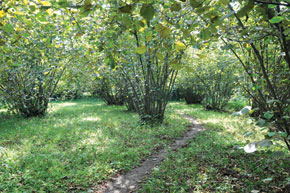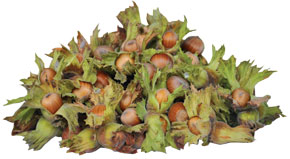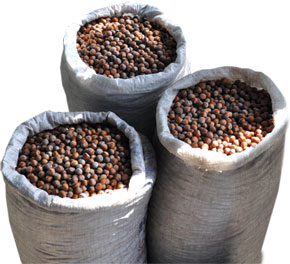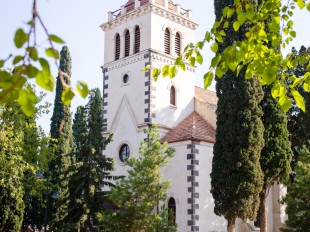 Pages 102-103
Pages 102-103by Nushaba Huseynli
The first time I saw hazelnut orchards those endless green spaces were like something from the Indian movies I watched in my youth. I imagined Indian movie stars going through at least five costume changes while singing their declarations of undying love and devotion below those bushes.
The gentleness of hazel trees (actually, bushes) which take root from one point and throw out multiple stems and leaves, reaching for the green sprouts of its neighbours as though desiring to merge with them, creates an unexpectedly romantic, sentimental mood of intrigue. Don’t blame me, but your feelings betray you into believing that, right now, a beauty with a mark between her eyebrows and a handsome man with muscled arms thicker than her waist will appear from behind the bushes. A sensitive person’s heart will pound. Aha … the sound of footsteps … someone is coming…
Yes… this is … no, no, the tale ends here. Actually, it was the owner of this house or, to be more exact, the owner of the orchard we have been praising, a woman in a headscarf, a shawl around her waist, carrying a bag in one hand, a bucket in the other and accompanied by her husband and children. In short, she is an ordinary countrywoman coming to harvest her orchard. The woman would never have guessed our thoughts of just a few moments before and was simply interested in how many nuts she would collect. By the way, local people call the hazel tree a pile and, for example, when people are interested in the sizes of each other’s gardens, they ask how many hazelnut piles they have. In response you can hear 40, 50, even 100 piles. As we said, a pile means a tree and each tree usually has 20-30 thick bushy branches.
Eyes look to the sky for 9 months and to the ground for 3 months
There is an interesting saying in regions known for their hazelnut orchards. It is rather more interesting for strangers than for the locals – we look to the sky for 9 months and to the ground for 3 months.
Is it a riddle, isn’t it? There is an explanation: in order to get a rich, healthy harvest from hazelnut bushes they need to be watered properly until the harvest. Water can be a real problem in rural areas and provinces which suffer from low rainfall, so the only resort is God’s mercy. Thus locals turn their eyes to the mysterious sky in hope of heavy rain for 9 months of the year. As time marches on, the first week of September arrives and rain becomes less important. It is the season of harvest. For the next three months precisely, including November, eyes turn from the skies and sweep the earth to seek out hazelnuts lying in the grass. Villagers don’t want to miss a single nut and, eyes glued to their native land, search every inch.
 Chatag…. pucha… jibriklamak … garzag…
Chatag…. pucha… jibriklamak … garzag… The hazelnut harvest has some very interesting features and traditions. The process begins with the shaking of the branches of the pile and this is carried out in three stages – first, second and third shaking. The biggest, best and healthiest hazelnuts are usually obtained from the second shaking.
The head of the family shakes the branches of the pile sequentially, his wife and children old enough to distinguish hazelnuts bend down, pick up and bag the nuts which fall around their heads like hail. Most of the nuts fall while still in their green husks, which embrace them as though hiding them from sight. But some hazels break out and throw themselves to the ground in just their brown shells. Of course they need to be collected too. Sometimes 2, 3, 4, or even 5 nuts cling together like a bunch of springtime violets. Local inhabitants call this a chatag (joined together). I have to say that these chatags are quite beautiful. Coming across them is as delightful as catching a bride’s bouquet at a wedding. A complete bunch of plump nuts lifts the spirit. But it is not always like this. Sometimes the green husks are pressed too close together in the chatag and the nuts are small, dark and difficult to remove. It is better not to waste your time, anyway the hazelnut is pucha ( puç - empty), in other words not healthy.
When the large bags are filled to the brim, they are carried by whoever can manage them back to the house. The nuts are poured out in the middle of the glass verandah which is usually emptied beforehand. Eventually a small mountain of hazelnuts is piled up. In the evening all the family, except for the one responsible for providing tea and food, gather around the nut mountain, seated on floor cushions. Passing on the gossip, talking about someone’s cow, another one’s butting calf, they set to pulling the nuts from the green husks. This process is called jibriglamag or jurugullamag. Hazelnuts pile up in one side and husks on the other. This time two hills are formed. The fast-decaying hill of husks (garzag) is put into large bags and disposed of in a far, unused corner of the garden. They gradually darken and mix with the earth.
Once a house, a car… and now clothes, dowry…
The hazelnut is literally a godsend to the livelihoods of inhabitants of the regions cultivating it. Bushes which are given no special attention or are sometimes dug over, produce an average of half a ton to a ton of nuts per season. The harvesters keep a small part of the yield for themselves, as they require, and deliver the rest to special points fixed within the village. They are immediately paid a defined sum per kilogramme.

Unfortunately, hazelnut cultivation seems to be losing its attraction. According to one villager, the hazelnut which was sold for 1.5 AZN per kilogramme is no longer accorded such respect. In former times it was possible to build a house, buy a car, in short, to meet villagers’ needs, from the profit made at harvest. Now, income from the harvest is hardly enough to pay back debts, people can only buy a few new clothes and inexpensive items for a dowry. Villagers are frustrated each season in trying to achieve a higher price. Those who set the prices seem to think that harvesting is easy, merely picking nuts from the ground. This is why prices are so low. But it should not be forgotten that next day the hazelnuts picked up from the ground will be the most interesting feature of our national table, as a dessert. Various sweets are made from the hazelnut, a most respected and important part of the festive table at Novruz, our national holiday celebrated at the spring equinox. Hazelnuts are also traditionally put into the hats that children leave at the doors of neighbours and relatives during the holiday. Even if hazelnuts don’t get their just reward, they must not lose their place and position on our tables!
With good wishes for an abundant harvest!


